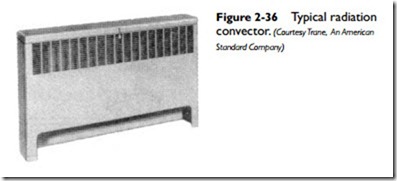Troubleshooting Radiators
If a radiator in a hot-water or steam heating system is not producing enough heat (or not producing heat at all), it may not be the fault of the radiator. Check the room thermostat and the automatic fuel-burning equipment (gas burner, oil burner, or coal stoker) to determine if they are malfunctioning. Methods for doing this are detailed in the appropriate chapters of Volumes 1 and 2. If you are satisfied that they are operating properly, the problem is probably with the radiator.
Hot water or steam enters a radiator at an inlet in the bottom and must rise against the pressure of the air contained in the radiator. A radiator is equipped with an automatic or manual air valve at the top to allow the air to escape and consequently permit the water or steam to rise.
In radiators equipped with automatic air valves, rising water or steam usually has enough force to push the air in the radiator out through the valve. The valve is automatically closed by a thermostatic control when it comes in contact with the hot water or steam. If a radiator equipped with an automatic air valve is not producing enough heat, the valve may be clogged. This can be checked by closing the shutoff valve at the bottom of the radiator and unscrewing the air valve. If air begins to rush out, open the radiator shutoff valve to see if it will heat up. An increase of heat is an indication that the air valve is clogged. Close the radiator shutoff valve again, remove the air valve, and clean it by boiling it in a solution of water and baking soda for 20 or 30 minutes. The radiator should now operate properly.
A radiator equipped with a manual air valve should be bled of air at the beginning of each heating season. It should also be bled if it fails to heat up properly. This is a very simple operation. Open the manual air valve until water or steam begins to run out. The water or steam running out indicates that all the air has been eliminated from the radiator.
Sometimes radiators are painted to improve their appearance. When a metallic paint (such as aluminum or silver) is used, the heating efficiency is reduced by 15 to 20 percent. If you must paint a radiator, use a nonmetallic paint for all surfaces facing the room. Dirty surfaces will also reduce the heating efficiency of a radiator. A good cleaning will eliminate the problem.
Convectors
A convector is a heat-emitting unit that heats primarily by convection. In other words, most of the heat is produced by the movement of air around and across a heated metal surface. The air movement across this surface can be gravity-induced or forced. As a result, convectors are classified as either gravity air convectors or forced- air convectors. They are used in hydronic (forced hot-water) and two-pipe steam heating systems.
Small, upright gravity and forced-air convectors are commonly found in older heating installations. The design of this type of unit was probably influenced by cast-iron radiators. A much more efficient convector is the fin-and-tube baseboard unit (see Fin-and- Tube Baseboard Units in this chapter).
An example of a modern convector is illustrated in Figure 2-36. The convector cabinets are available in a variety of different baked- on enamel color finishes. Some convectors have a small door on the front of the cabinet to provide entry for cleaning the heating element (see Figure 2-37). On other convectors, the entire front panel will swing upward for access. The heating element consists of aluminum fins attached to three copper tubes (see Figure 2-38). The tubes are supported by brass headers and hangers on each end of the assembly.
The rating of convectors used in hot-water heating systems is determined by water temperature, temperature drop, and inlet air temperature. The rating of those used in steam heating systems is determined by steam pressure and the entering air temperature. The convector manufacturer provides specifications for its convectors, including sizing data tables.
